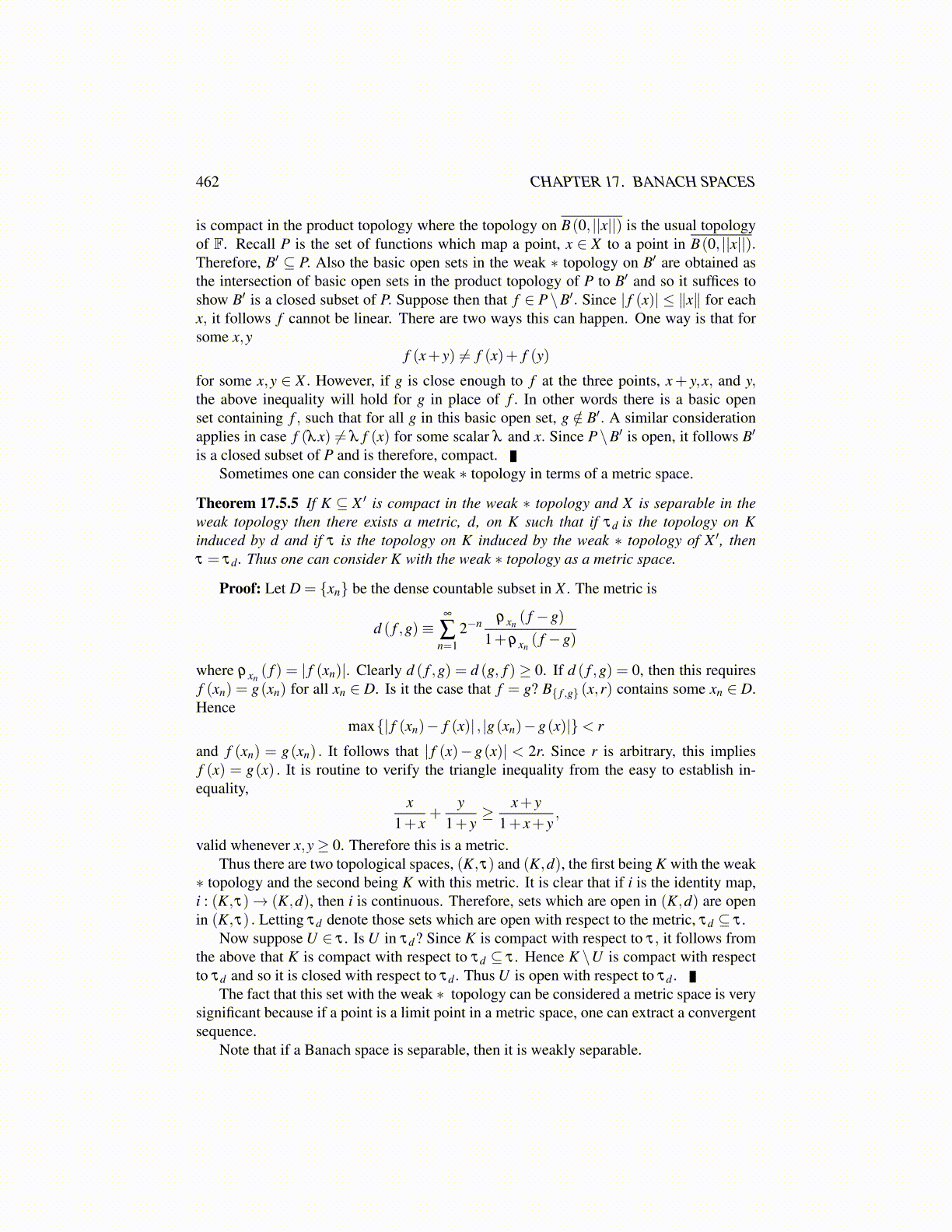
462 CHAPTER 17. BANACH SPACES
is compact in the product topology where the topology on B(0, ||x||) is the usual topologyof F. Recall P is the set of functions which map a point, x ∈ X to a point in B(0, ||x||).Therefore, B′ ⊆ P. Also the basic open sets in the weak ∗ topology on B′ are obtained asthe intersection of basic open sets in the product topology of P to B′ and so it suffices toshow B′ is a closed subset of P. Suppose then that f ∈ P\B′. Since | f (x)| ≤ ∥x∥ for eachx, it follows f cannot be linear. There are two ways this can happen. One way is that forsome x,y
f (x+ y) ̸= f (x)+ f (y)
for some x,y ∈ X . However, if g is close enough to f at the three points, x+ y,x, and y,the above inequality will hold for g in place of f . In other words there is a basic openset containing f , such that for all g in this basic open set, g /∈ B′. A similar considerationapplies in case f (λx) ̸= λ f (x) for some scalar λ and x. Since P\B′ is open, it follows B′
is a closed subset of P and is therefore, compact.Sometimes one can consider the weak ∗ topology in terms of a metric space.
Theorem 17.5.5 If K ⊆ X ′ is compact in the weak ∗ topology and X is separable in theweak topology then there exists a metric, d, on K such that if τd is the topology on Kinduced by d and if τ is the topology on K induced by the weak ∗ topology of X ′, thenτ = τd . Thus one can consider K with the weak ∗ topology as a metric space.
Proof: Let D = {xn} be the dense countable subset in X . The metric is
d ( f ,g)≡∞
∑n=1
2−n ρxn( f −g)
1+ρxn( f −g)
where ρxn( f ) = | f (xn)|. Clearly d ( f ,g) = d (g, f ) ≥ 0. If d ( f ,g) = 0, then this requires
f (xn) = g(xn) for all xn ∈ D. Is it the case that f = g? B{ f ,g} (x,r) contains some xn ∈ D.Hence
max{| f (xn)− f (x)| , |g(xn)−g(x)|}< r
and f (xn) = g(xn) . It follows that | f (x)−g(x)| < 2r. Since r is arbitrary, this impliesf (x) = g(x) . It is routine to verify the triangle inequality from the easy to establish in-equality,
x1+ x
+y
1+ y≥ x+ y
1+ x+ y,
valid whenever x,y≥ 0. Therefore this is a metric.Thus there are two topological spaces, (K,τ) and (K,d), the first being K with the weak
∗ topology and the second being K with this metric. It is clear that if i is the identity map,i : (K,τ)→ (K,d), then i is continuous. Therefore, sets which are open in (K,d) are openin (K,τ) . Letting τd denote those sets which are open with respect to the metric, τd ⊆ τ .
Now suppose U ∈ τ . Is U in τd? Since K is compact with respect to τ, it follows fromthe above that K is compact with respect to τd ⊆ τ . Hence K \U is compact with respectto τd and so it is closed with respect to τd . Thus U is open with respect to τd .
The fact that this set with the weak ∗ topology can be considered a metric space is verysignificant because if a point is a limit point in a metric space, one can extract a convergentsequence.
Note that if a Banach space is separable, then it is weakly separable.